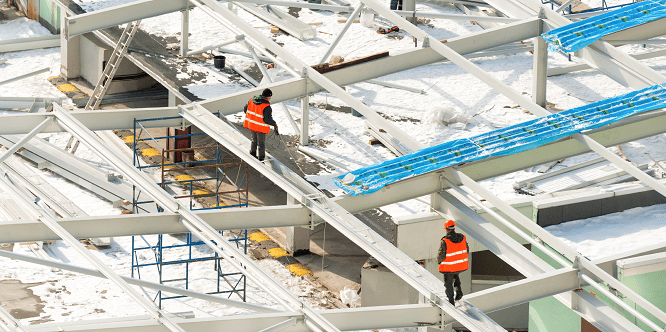TAKEAWAY: The winter brings snow and ice to many parts of the US and Canada. Although it presents a picturesque landscape, snow and ice can prove treacherous for those working on outdoor job sites. Fortunately, armed with knowledge, you can take the necessary precautions to work safely on snowy or icy terrain and minimize the risk of devastating injuries.
Jump Ahead
According to 2020 data from the Centers for Disease Control and Prevention (CDC), 18 percent of nonfatal work injuries resulting in days away from work were related to slips, trips, and falls. This category was one of the leading causes of work-related injuries resulting in a visit to the emergency department.
Canadian data is similar. Around 18 percent of time-loss injuries reported to worker’s compensation boards annually are due to falls. Interestingly, the majority (67 percent) of falls result from slips and trips as opposed to falls from heights.
Various factors can increase the risks of slips, trips, and falls. From inappropriate footwear to uneven ground or slippery surfaces, employers and employees must first be aware of the risks and then take steps to minimize them.
Snowy and icy terrain can prove very slippery, increasing the chance of falling over and sustaining an injury. Read on to discover the top ways to minimize the risk of slips, trips, and falls on snowy and icy job sites and avoid related injuries.

SureHire offers a wide range of occupational testing programs and additional resources to support employers and their workers, including audiometric testing, fitness-to-work testing and lung health testing.
The dangers of snowy and icy job sites
Snow and ice can produce slippery surfaces, increasing the risk of slips and falls for employees working outdoors. Early morning wintery conditions are often the worst. Melting snow freezes overnight as temperatures drop, forming a thin layer of early morning ice that can be hard to see.
Falling on icy ground can cause serious injuries that often have a negative and long-term effect on workers and businesses. Injuries can vary in nature and severity, ranging from muscle strains and sprains to broken bones and concussions.
Injured employees may require time off work, medical care, and a rehabilitation program. Injuries can adversely affect not only a person’s physical health but also their mental well-being.
Work-related injuries can also prove costly for businesses, from medical expenses to reduced worker productivity and, ultimately, a diminished bottom line. Therefore, employers and employees should proactively find ways to stay safe on snowy and icy job sites.
How to avoid slips, trips, and falls on snowy and icy job sites
Employees can take the following actions to minimize the risk of slipping and falling when working on snowy and icy job sites.
1. Wear appropriate footwear
Icy surfaces present reduced frictional force between your foot and the ground, increasing the chances of slipping. Wearing appropriate footwear can help improve traction and keep you safe while walking. Always wear flat-footed shoes or boots for walking on snow and ice.
Winter boots can help keep feet warm and dry, and those with good grip will help reduce the risk of slipping on ice. Wear boots designed for winter weather, such as snow boots or walking boots with metal spikes. Boots also offer ankle support, which may reduce the risk of sprained ankles.
If your footwear isn’t optimal for walking on snow and ice, invest in a pair of traction cleats, also called crampons. They fit easily over various types of footwear for a much smaller cost than specialized boots.
2. Adjust your walking style and speed
Your usual walking style may serve you poorly when walking on icy surfaces. Instead, take smaller steps and adopt more of a shuffle to help you keep stable on your feet. A slight forward bend can also help you maintain your center of balance.
Something as simple as slowing down can go a long way toward keeping you safe. So allow plenty of time to get where you need to go, take your time, and walk slowly. Although it may be tempting to keep your hands cozy inside your pockets, keeping them free is vital to help protect you if you fall.
3. Wear appropriate protective clothing
Your clothing might not be the first thing that comes to mind when looking to protect yourself from slips and trips. However, your clothing choices can help you considerably if you do fall.
Wear a thick winter jacket to help soften your landing. Grippy gloves increase traction with handrails and help you avoid slipping further if you fall.
4. Use support if it’s available
Handrails are there for a reason, so use them if available. They are beneficial on stairs where the injury risk is likely higher if you fall.
5. Pay attention to your surroundings
Paying attention to your surroundings is a simple concept that can ensure you avoid slips and trips caused by distractions. Look ahead when you walk and take note of any changing terrain. Sometimes you’ll need to change your course to avoid slippery or uneven areas.
Never read or look at your phone while walking on snow or ice. Keep your sole focus on walking for the best chance of staying safe and injury-free.
6. Take extra care with entries and exits
Take extra care when the surface conditions change to avoid getting caught off guard. Climb in and out of vehicles slowly and carefully. Do the same when walking from inside to outside a building to allow your brain and body to adjust to the new environment.
When entering a building, take care to wipe your feet on a mat, stamp out any snow and ice from your footwear, or change to indoor footwear. It’s not only outdoor job sites that require you to take on care during winter. Bringing snow and ice indoors becomes slippery when it melts, making indoor surfaces more hazardous.

SureHire offers a wide range of occupational testing programs and additional resources to support employers and their workers, including audiometric testing, fitness-to-work testing and lung health testing.
You May Also Be Interested In…
- Do You Have Reasonable Suspicion?
 Employers cannot initiate reasonable suspicion testing without first going through the 5-step process. Reasonable suspicion training provides critical information about how to initiate reasonable suspicion testing, including the 5-step process and other tools that employers can use to help manage the misuse of alcohol and drugs in the workplace.
Employers cannot initiate reasonable suspicion testing without first going through the 5-step process. Reasonable suspicion training provides critical information about how to initiate reasonable suspicion testing, including the 5-step process and other tools that employers can use to help manage the misuse of alcohol and drugs in the workplace. - An Employer’s Guide: What You and Your Employees Need to Know About DOT Drug & Alcohol Testing
 When implementing or maintaining DOT Drug & Alcohol testing, there are key areas that employers should consider.
When implementing or maintaining DOT Drug & Alcohol testing, there are key areas that employers should consider. - SureHire Occupational Testing Acquires COHR Health: A Positive Step Towards Safe, Healthy, Productive Workforces and Communities
 We are thrilled to announce that today, May 6, 2024, SureHire Occupational Testing has officially acquired COHR Health, a well-known leader in occupational health services. Read on…
We are thrilled to announce that today, May 6, 2024, SureHire Occupational Testing has officially acquired COHR Health, a well-known leader in occupational health services. Read on… - Occupational Testing Use Case – Mining
 In this case study, we will explore how mining companies can use various types of occupational tests to reduce Total Recordable Incident Rates (TRIR) long term.
In this case study, we will explore how mining companies can use various types of occupational tests to reduce Total Recordable Incident Rates (TRIR) long term. - 9 Strategies to Keep Workers Cool on Drilling Sites During Hot Summer Months
 This article delves into strategies to keep workers cool and safe on drilling sites during the hot summer months.
This article delves into strategies to keep workers cool and safe on drilling sites during the hot summer months. - Hearing Conservation Basics: How to Manage Occupational Noise
 Learn how to proactively mitigate occupational noise risks and help prevent NIHL among workers.
Learn how to proactively mitigate occupational noise risks and help prevent NIHL among workers.

